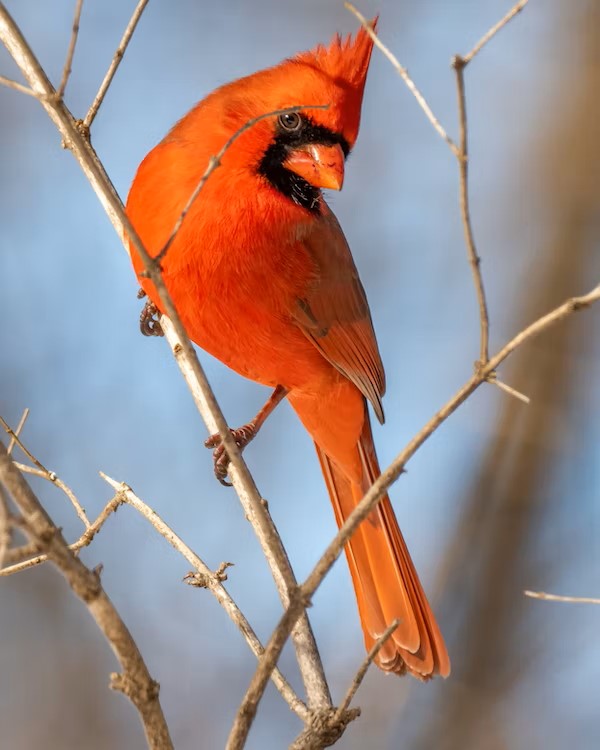The great thing about birds of the Midwest is that there’s always something new! Not only are there a wealth of birds who call this area home year-round, there also are many migratory birds who will make brief, showstopping appearances as they travel.
Older adults benefit from watching their feathered friends. Studies have shown that birdwatching promotes mental and physical health for older adults. Remembering bird calls, noting small differences in species, and marking migratory patterns are all excellent cognitive exercises. For those who have access, exploring new places and getting outdoors is a great opportunity for physical exercise and grounding oneself in nature.
Year-Round Birds
We see them often but what do we know about our regular year-round birds, really? Let’s do a roll call of year-round birds of the Midwest!
Northern Cardinal
Even those who don’t give a feather about birds can usually spot a male Northern Cardinal due to his black face and crimson crest, beak, and body. If you’re a fan of the St. Louis Cardinals Major League Baseball team, that makes it even easier! Females have soft, tawny feathers. They are often in male-female pairs and can be seen at feeders. The Cardinal is one of the most popular state birds and mascots. Keep your feeder filled with black sunflower seeds to attract this bird of the Midwest.
Blue Jay 
It’s hard to mistake a Blue Jay for any other bird, with its distinctive crest, bright blue coloring, and loud call. They are often regarded as “bullies” at bird feeders because they can be aggressive to other birds. Due to their adaptability, you can find them in wooded areas or suburban neighborhoods.
Mourning Dove 
These ground feeders are the most widespread dove in North America. You can identify them from their cooing, which can sound like an owl hoot. They are typically brownish gray with dark spots on their wings, a light-blue eye ring, and a sharp, pointed tail.
American Crow 
American Crows are large, all-black birds that have a distinctive harsh “caw” call. Have you ever looked at a large black bird and tried to decide – Crow or Raven? Remember that Ravens are larger, about the size of a Red-tailed Hawk. Ravens usually travel in pairs while Crows are in larger groups, called a “murder.” If you watch them fly overhead, a Crow’s tail feathers open like a fan while a Raven’s appear wedge-shaped.
European Starling 
We have Shakespeare fans to thank for this bird’s existence in North America! According to legend, in 1890 someone thought America should have every bird mentioned in Shakespeare’s plays and so released a pair of European Starlings in Central Park in New York City. Today, they are birds of the Midwest and beyond. These medium-sized foragers with a yellow bill and oily black feathers are found in huge flocks across North America and have proved fierce competition for native bird species.
Northern Mockingbird 
You’ve probably seen these gray bodied birds whose black wings are adorned with white bars, and a perky tail feather, hopping across a lawn. They get their name for their ability to mimic sounds. According to the National Audubon Society, “Northern Mockingbirds have been known to imitate machinery, perform near-perfect versions of human sounds like music and car alarms, and can even mimic frogs and toads.”
White-Breasted Nuthatch 
This bird stands out for its unusual looks and habits. With a pale belly, slate back, black cap, and streamlined shape, you’ll notice it at the bird feeder. It also stands out by its habits of preferring to perch upside down and food hoarding. They take seeds from feeders and hide them in spots, like loose tree bark, for later snacking.
House Finch 
These small birds are very common visitors to feeders in suburban and urban areas. You’ll note that males have red faces that fade to brown down their neck and breasts. Like the Eastern Starling, human intervention led to their abundance. They were found only in the American Southwest until 1940 when a New York pet shop that was illegally selling them released them into the wild to avoid prosecution. Today their range spreads across the United States and are one of many birds of the Midwest.
Red-Bellied Woodpecker 
You’ll notice the red cap on its head more than the splash of red on its belly for which it is named. This medium-sized woodpecker has an extra-long tongue that can reach two inches past its beak.
Downy Woodpecker 
Woodpeckers make it easy to find them thanks to their hammering. The Downy Woodpecker is the smallest and the one you’re most likely to spot due to its abundance. Don’t worry about them knocking themselves out – they basically have built-in shock absorbers! Their enlarged, reinforced brain case allows their brain to sit higher than the impact zone.
Gallery of Year Round Birds
Seasonal Birds
Thanks to migration, birds of the Midwest vary by season. Depending on the time of year, here are some migratory birds of the Midwest you may see.
American Robin
Not all Robins migrate but they are commonly associated with the return of springtime. According to the Audubon Society, the male Robin declares his personal nesting territory with a call that sounds like “cheer up, cheer up, cheerily.” Unlike many birds, Robins do not maintain mating pairs.
Dark-Eyed Junco 
While it’s wintery to us in the Midwest, the small, gray-and-white Dark-Eyed Junco is on a warm vacation compared to its native home of the coniferous forests in Canada and Alaska. The small dark birds nest on ground and eats seeds and fruit. You usually see them October through April. They are called “snowbirds” because their arrival usually marks the beginning of winter and their departure marks the start of spring.
Bald Eagle

Winter is a great time for Eagle watching. When lakes and rivers freeze over, Bald Eagles congregate in large trees along shorelines where dams and power plants provide open water where they can fish. With a seven-foot wingspan, this is one of the largest raptors in the world. They really stand out from other birds of the Midwest!
Snowy Owl 
Snowy Owls breed in the treeless Arctic tundra, so when they come down into Midwestern states, they seek out the same open habitat. Look for them in farm fields, near airports, over large wetlands, and along coastal areas. Male Snowy Owls are almost completely white, while females are white with dark bars on her white plumage. Their adult wingspans range four to five feet. Unlike most Owls that are nocturnal, Snowy Owls are diurnal and so you may see them hunting during daylight hours.
Orchard Oriole 
The Orchard Oriole is the smallest species of Oriole in North America. They are sometimes confused for Warblers, due to their small size and bright coloration. Adult male Orchard Orioles are predominately chestnut in color. Females and juveniles of both sexes look very different, with olive and yellow plumage. Orchard Orioles migrate at night and leave their breeding grounds as early as late July.
Purple Martin
Purple Martins are very large, broad-chested dark Swallows. They have stout, slightly hooked bills, short, forked tails, and long, tapered wings. Adult males have a dark blue-purple body with brown-black wings. Females are duller with gray on the head and chest. They are found in flocks so large that they can be seen on weather radar. These birds of the Midwest originally lived in old Woodpecker holes but have adapted to living in human-made Purple Martin houses.
Gallery of Seasonal Birds
LSS Communities: Perfect for Bird Lovers
Due to their scenic settings, residents at many Lutheran Senior Services Life Plan Communities enjoy wonderful opportunities to view birds on the community grounds or from their own windows. Bird watching is a great hobby and their communities are great places to do it! No matter the season, there are always interesting birds of the Midwest to see. Now it’s time for you to explore common birds of the Midwest. How many can you spot?


















